
What is pulse survey : A complete guide to help you assess the pulse of your organization



When it comes to collecting timely feedback from employees using long, annual employee engagement surveys, it’s almost always a challenging task. Either employees don’t take the initiative seriously, there is a lack of trust in the organization, the surveys are not communicated effectively, or they are simply way too long.
And now with remote work (which, by the way, we didn’t think would last so long) having become the new normal across organizations, managers and HR leaders have a new situation at hand. With employees dispersed across locations and working from homes or anywhere they like, there is a compounded need to collect frequent feedback from employees.
Annual surveys alone may not work the magic anymore.
You’ll need to collect more regular feedback from your employees experience without taking much of their valuable time. And how can you do that?
Through pulse surveys.
Although there are multiple ways to collect feedback from your employees like annual engagement surveys and life cycle surveys, pulse survey has been an up and riser in recent times as it is a tool that can collect short and frequent feedback from employees in comparison to other types of surveys.

The annual employee engagement survey only gets a 30-40% response rate, while pulse surveys enjoy an average response rate of more than 50%. (Forbes)

There still exists some confusion, though, around what exactly a pulse survey is and how it can benefit business leaders in measuring and improving employee engagement.
We’ll run you through everything that you’ll ever need to know - about what pulse survey is, its history, significance, best practices, and much more. Stay hooked.



What does an employee pulse survey actually mean?

Pulse surveys are engagement surveys that are easy to implement, have fewer questions, and can help you get regular feedback from your employees.
As the name suggests, pulse surveys are designed to help you collect anonymous feedback from your employees by asking more pointed questions about - employee satisfaction, work-life balance, recognition, and much more on a monthly, weekly, or fortnightly basis.

But, mind you, a good employee pulse survey is not just about turning long surveys into fragmented little surveys. Employee pulse surveys are usually a set of questions that are asked repeatedly over a period of time to measure progress in a certain area of employee engagement or, are quick ways to collect feedback on any change within the organization.

A pulse survey will tick all the right boxes for you in terms of getting frequent feedback from your employees, higher actionable responses for the survey, and more honest participation.
But, here's the catch. No staff pulse survey can be of help to any organization unless the employee feedback is acted on. Collecting employee feedback and generating engagement reports are not enough. You have to start acting on the feedback and communicate the same with employees. Nothing short of this can instill trust among employees towards the leadership.
In short, the real key to the success of a pulse survey mechanism is how you convert employee feedback into dialogues that influence action and deliver quantifiable business outcomes.

History of employee pulse surveys

Though employee pulse survey is relatively new, it is currently the talk of the town for its ability to gather quick responses and present actionable insights on employee behaviors. The process of getting feedback from employees began in the 1920s, and back then it was called “employee attitude surveys” which were used to measure employees' attitudes and morale towards the work environment.
But did you know that the concept of employee surveys has been in existence for more than a century?
During World War I, most industrial leaders were concerned about the attitude of their employees as it led to labor strikes and resource shortages during wartime. In response, leaders had to come up with a scientific approach to workforce management.
Like how William Horman rightly said, “Necessity is the mother of invention”. A pressing need challenged the leaders from that era to implement an attitude survey. They asked employees questions about the management and coded the responses on a scale of one to five through agreeable or disagreeable context.
This process helped them formulate an average attitude score that they could use to compare and track engagement levels amongst the employees of various departments.
Even though conducting employee surveys back then was way ahead of its time, it had its limitations. Surveys were based on a paper - pen approach and did not guarantee employees any anonymity. As a result, employees were not very confident enough in expressing unbiased feedback in the fear of negative consequences.
Cut right to the late 1990s and early 2000s. We witnessed the technological era where employee surveys began to be conducted quickly securely over the internet. Except for moving to a more digital process, there was no significant change in the employee survey mechanism during this period.
Thanks to cloud - based software, running surveys is easy, less expensive, and readily accessible. Cloud - based employee engagement platforms have made it possible for organizations to enhance their capabilities when it comes to conducting employee surveys and has enabled them to measure trends and the pulse of their employees more frequently.
One conclusion to the evolution of employee surveys is this: across time, there has always been a need for behavioral science practices to increase employee engagement, even as we probably lacked the tools to fully make it happen.
It is safe to also assume that getting feedback from employees is not a recent trend data, instead, it has been at the core of developing a good company culture from the very beginning.

Pulse survey vs annual engagement survey

Engagement surveys are most widely used by leadership teams to gauge the engagement levels of their employees. By asking employees a series of questions about their employee experience in the organization, action plans are formulated to improve employee engagement.
And most organizations conduct these engagement surveys annually.

Annual engagement surveys usually serve as a year-on-year comparison of the engagement levels of employees. These surveys collect and unearth a lot of valuable data from the entire organization for deeper analysis which can then be eventually used for goal setting and finding ways to improve employee satisfaction, work culture, and company values.
But leaders need to understand that, no matter how good an annual engagement survey is, it is not just enough. Engagement surveys that are run annually are nothing but a yearly report. With no real-time information handy, acting on insights from annual surveys is a backward-looking exercise.
Imagine having run an employee survey in January 2020, right before the pandemic. You got the insights you needed and have a great action plan in place until the next survey in 2021. But as you spent the next 365 days implementing every big and small task on that action plan, a pandemic shook the world, employees started working remotely, people fell ill and so much more happened.
Would that action plan based on an annual survey run in January have any credibility once the pandemic struck? Because by then, the needs of your employees would have had changed drastically.
Yes, we agree that this is an extreme situation and most probably, a one-off instance. But a lot of things change over a period of 365 days including your employees' engagement levels, loyalty to the organization, motivation to work, and more.


Based on Dynamic Signal’s study in which 1001 US employees were surveyed, they found that 63 percent have wanted to quit because of ineffective and infrequent internal communications from their leadership team.
So how exactly is a pulse survey better than an annual survey?
Unlike annual surveys, complete pulse surveys are more frequent, specific, and much shorter in size, which will give you real-time insights into your employees’ engagement levels without causing your employees any survey fatigue.
Pulse survey questions let you ask targeted questions to a specific group of people about the current employee affairs and over a period of time. Such timeliness can help gauge the mood of your employees after a recent appraisal season, gather employees' views about a recent policy change in the company, their requirements in professional development opportunities, and much more.
This aspect of the pulse survey would provide you a level of transparency that would never be achievable with an annual survey alone.
The insights from regular pulse surveys help managers resolve an issue then and there without letting that convert into a larger problem, say, the cause for attrition. It is this aspect of the pulse survey that makes it widely popular in leadership circles.
| Pulse survey | Annual engagement survey | |
| Quality of data collected |  |  |
| Real-time data analysis |  |  |
| Immediate actionability |  |  |
| Tracking of workplace trends |  |  |
| Comprehensibility |  |  |
| Frequency | Regular | Once in a year |
Significance & benefits of pulse survey
We’ve already discussed how significant the pulse surveys are for gathering employee feedback more frequently while keeping the survey short. But that’s not the entire picture, here’s what makes pulse survey a cool choice:


Running a pulse survey is simple. If you have access to any decent employee engagement software out there in the market, running a pulse survey and collecting data from your employees is super simple.
But that’s only the beginning of the massive exercise.
The data needs to then be crunched and reports need to be generated.
And if the reports generated from the employee data don’t reach the managers and leaders in time, then this whole exercise might turn into a negative employee experience for the employees as they see no action being taken on the relevant feedback they shared.
Oftentimes, carefully investing in reliable technology is the first and right step you need to take. When it comes to pulse survey software, it is important to buy one that can analyze the data and create reports at speed, helping you act faster.


Wondering who we are, and why we wrote this?
We are CultureMonkey, an AI powered employee engagement software. Simply put we help you listen to your employees better.
How to launch your pulse survey?


Collating questions, collecting data about the recipients, and putting up google forms to run pulse surveys for your employees sounds least bit fun, right? Especially if you have to do it alongside the million other things that need your attention right now.
The next best bet is outsourcing it to an employee engagement consultant. Unfortunately, their process would not be much different. The same old Google forms and time - consuming manual processing will not give you magical results except take that workload off your table.
If you ask us, we would suggest you to invest in an employee engagement software or a pulse survey software.
For instance, CultureMonkey is an employee engagement platform carefully designed to help you listen, analyze and act on employee feedback and will help you in sustaining and growing your employee engagement.
Unlike other employee pulse survey tools or methods that take hours, days, and weeks of your time in setting up the process, CultureMonkey lets you assess the pulse of your employees in very simple steps and generates insightful reports with just a click of a button.
Let's quickly walk you through how to launch your first pulse survey for your employees with CultureMonkey.
Step 1
Select a frequency for your pulse survey
Ideally, the frequency of a pulse survey is dependent on how many questions you ask, the number of engagement drivers you’re covering within a survey, and most importantly, the time required by you to take meaningful action on the survey responses and results.
Generally, it is ideal that you only send one or two pulse survey questions in one go.
And, when it comes to scheduling, following a weekly/bi-weekly or monthly frequency will help you collect honest feedback from your employees without causing them survey fatigue.
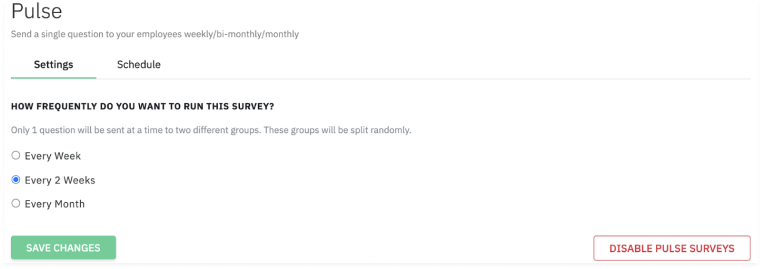
Bonus
CultureMonkey’s pulse survey tool also lets you disable a pulse survey whenever you want without affecting your reporting.
Remember, there isn’t a one-size-fits-all approach to choosing your pulse survey frequency. Therefore, maintain a frequency that works both in receiving and resolving your employees’ feedback.

Why choosing the right employee survey questions is important?
Step 2
Select employee pulse survey questions and launch the survey
Pulse surveys are all about asking a few survey questions, powerful enough to get the responses for what you want to know.
But a common problem while setting up a pulse survey is that there are way too many good survey questions out there! Naturally, you are bound to feel confused about which to choose and which one to ignore.
And most often than not, what was supposed to be a 2-3 question long pulse survey swells into what looks like an annual survey with way too many questions.
Here’s where you need to check yourself and ensure you pick and choose the best questions that meet your objective.
Or, use a tool like CultureMonkey, where you can automatically choose the pulse survey questions from our pre - built pulse survey templates that measure 15 + organizational engagement drivers.
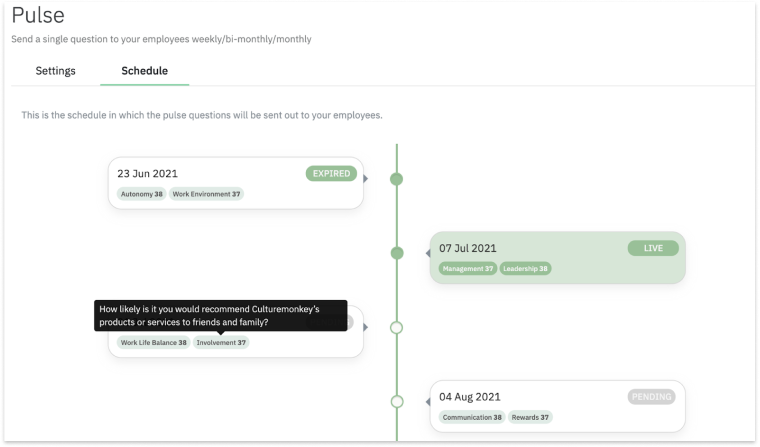
Bonus
Every pulse survey sent from CultureMonkey mandatorily contains the e-NPS question to gauge how likely your employees are to recommend your company to their friends and family for work.
CultureMonkey also visualizes the entire pulse check timeline for you to see what questions are sent in a sprint, and which engagement driver is being measured - across the past and future of a pulse survey schedule.


Step 3
Analyze the feedback from your pulse survey and generate meaningful insights
Now, here comes the best part of any pulse survey - analyzing the pulse survey data and getting valuable insights out of it. But when it comes to data analysis, there’s a blocker for most organizations and that is comprehensibility.
We know that, in general, responses to surveys are nothing but loads of information and numbers that take you nowhere unless there is someone who can make meaning of it, say, like a data scientist. No matter how smart a data scientist is, they are bound to need some time to be able to draw out insights for you. But if you wish to skip this step and get access to reports that are comprehensible even for a layman and without being dependent on an analyst to interpret those reports, then CultureMonkey provides you just that.
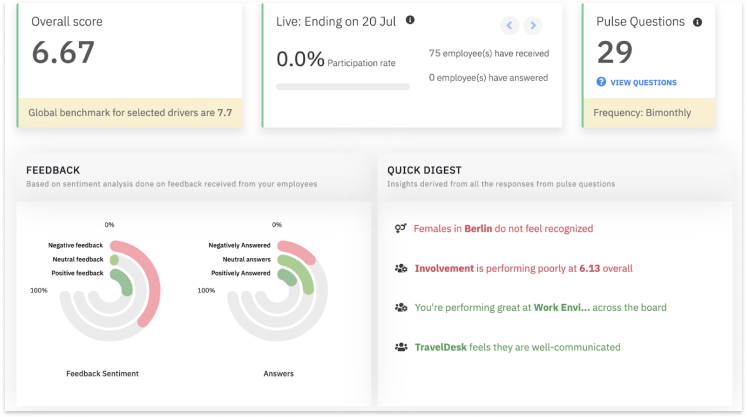
CultureMonkey’s pulse survey tool gives you an eagle’s eye view of the pulse of your organization by offering you comprehensive reports on overall pulse score, survey response rate, and questions asked in the current survey sprint. Also, the reports will automatically keep populating after the end of each survey sprint.
On top of that, CultureMonkey’s AI/ML algorithm analyzes the average sentiment of the feedback received, which is then classified into positive, negative, and neutral. Along with the feedback sentiment analysis, it also displays top positive and negative feedback in the report for you to be able to take action on the negative feedback at a much faster rate.
Enough about quick reports, now let’s deep dive into some real-time feedback reporting.
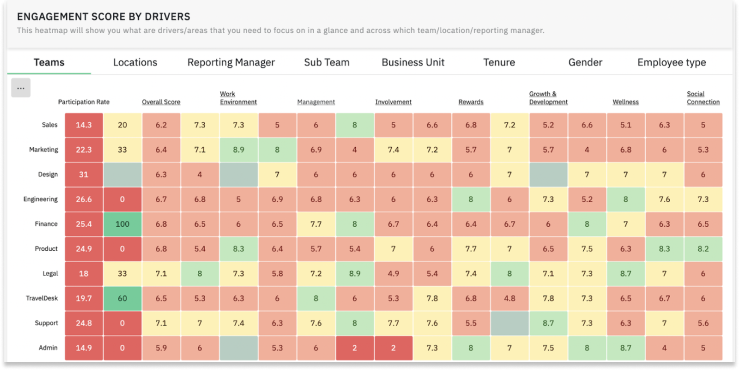
All the feedback collected through pulse surveys will be accounted for in the pulse heatmap, which will enable you to slice your pulse survey score across - teams, locations, reporting managers, gender, tenure, employee types, and much more.
This drill-down enables you to spot the low-scoring drivers, identify issues and unhappy teams to take necessary actions.
Well, there’s much more to cover about CultureMonkey’s reporting features, but the idea is to make you realize the importance of clarity in reporting and how it can lead you to take meaningful actions on the feedback received.

Step 4
Take action on the feedback received
No matter how awesome the reporting is, if you are not able to convert the insights into actions, the whole point of running this pulse survey questions becomes meaningless.
But acting on employee feedback is not as easy as it sounds.
That’s why you need an employee engagement software that makes feedback management easier for you.
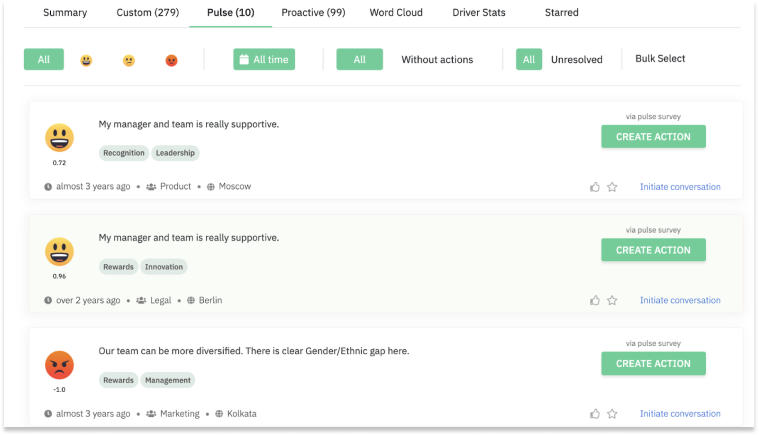
CultureMonkey’s feedback tool provides an overview of employee responses received, which lets you view feedback on the dashboard and create actions for it at the earliest.

You can use the Kanban board to enhance the feedback action mechanism. The Kanban board will help you sort your feedback into easily manageable stages like - To do, In Progress, and Completed, and enables you to manage feedback action items seamlessly.
Along with the regular feedback management system, CultureMonkey’s AI/ML algorithm also automatically suggests action items by analyzing the sentiment of the feedback received so that you don’t have to curate actions by yourself for every feedback received.
This way, you have every help needed to complete the feedback loop by taking necessary actions.


Pulse survey best practices
Pulse surveys, if used correctly, can benefit your organization in unimaginable ways. It's not just meant to be a regular survey but can actually serve as a leadership tool. Here are some of the best practices you can follow while running pulse surveys, whether you use a tool for it or not:

Don’t replace annual engagement survey with a pulse survey

Don’t replace the existing annual engagement survey with a pulse survey.
There might be many best practices to keep in mind while running pulse surveys. Out of them, the first and foremost practice is to always use pulse surveys as a supplement to annual engagement surveys.
Even though annual surveys are long, one should not discontinue running them. Those yearly understanding of the overall performance of the organization across drivers of employee engagement is equally important too.
These responses will help you analyze trends and themes over time and will help you see the bigger picture while planning your engagement strategy.

Make surveys mobile friendly


Mobile is how Millennials & GenZ access the internet, and in this new age where mobile internet is catching up to desktop usage, you should make your pulse surveys mobile-friendly so that your employees can respond to your survey questions on the go - anytime, anywhere, and on any device.

Set clear objectives for your survey


The first and foremost thing to do while launching a pulse survey is to announce and promote it internally to your employees. You need to tell them about what benefits it will bring them.
Secondly, make the objective clear while running a pulse survey. There is no point in running a pulse survey for the sake of running it if you do not have a solid strategy as to what to do with the data collected.
That’s why you need to have clarity about what you want to measure, what you are going to do with the pulse survey results, and how soon you could resolve your employees' issues.

Get feedback anonymously

Be it any kind of survey you run, anonymity in surveys is always of paramount importance.
The very fact that you keep the survey anonymous will improve your survey response rates, as it instills trust amongst your employees to provide honest feedback.
Not only that, anonymous surveys help in gathering constructive feedback, acts as a basis for discussion, and more importantly, give equal rights to your employees to provide feedback, no matter where they are in the hierarchy of the organization.


Choose relevant survey questions

The main aim of pulse surveys is to keep the survey as short as possible, whether it is a few questions you ask or the length of the question.
Ideally, it is recommended that you choose two to five questions per survey that cover various employee engagement drivers such as meaningful recognition, autonomy, work-life balance, e-NPS, etc.
Giving importance to keeping the survey short and also asking meaningful questions will help your employees respond better to surveys without causing them any survey fatigue.

Analyze the survey responses

Once you have completed running the survey, you would have lots of responses to make sense of.
Now, it's essential for you to review all the responses in detail without any bias, look for areas that need improvement, and reflect on positive changes.
You would need a pulse survey tool that could pull deep-insight reporting to analyze the trends and the survey results to take necessary actions on the feedback received.


Focus on resolving the feedback at a faster rate

Survey only as fast as you can act. While scheduling a pulse survey, you need to be mindful of what timeline you have set to resolve or take action on your employees’ responses.
That’s because if you’re collecting feedback and doing nothing with the data and insights it provides, you’re sending a wrong message to your employees - that you don’t value their time, which in turn can make the whole process lose its value.
Acknowledge employee feedback while solving it, and that gesture would make your employees believe that you care about their problems.
How to choose the right pulse survey software?
Enough said about most employee pulse surveys and their best practices. Let’s now talk about the things you need to keep in mind while choosing a pulse survey software because a pulse survey tool makes it easy to send surveys as part of your internal communication strategy, and enables building a strong company culture of feedback.
Here are seven elements to keep in mind when choosing the right pulse survey platform for your organization:


Easy to set up
Being an HR leader for an organization of any size is not an easy job. You have to deal with lots of high-impact tasks and you may not possibly have enough time to set and curate employee surveys from scratch.
That is why you must invest in a pulse survey tool:

That has a great UI/UX
Let's you easily schedule a pulse survey using readily available pulse survey questions
Run pulse surveys in an automated way with minimal intervention
Customizability
While choosing any feedback tool, you need to be sure that they offer customization to their existing features based on your needs because no matter how good it is, if its features don’t fit your requirements, the tool won’t do much good for you.

Customization here could mean anything that meets your requirements, like - the ability to send customized survey questions to generate customized reporting for you, and much more.
Anonymity and reachability
The first checkbox to click before running any survey is - to ensure that the surveys are 100% anonymous. Anonymity in surveys will drive better survey participation rates because your employees feel valued and uncomfortable coming forward with nothing but the truth as their feedback.

Not just that, you drive better response rates by making surveys easy to answer, by making it accessible to employees across various channels - SMS, email, Slack, Microsoft Teams, and more.
Easily consumable reports
When you choose a pulse survey software, one fact you have to know is that the software is as good as the real-time reporting it offers. The quicker you have access to the pulse survey data, the faster you can act.

Again, by real-time data, we don’t mean the sophisticated, good-looking ones where one can’t comprehend anything at all. Instead, the tool should be able to present a comprehensive report that’s easily consumable and insightful enough to let you start drafting actions right away.
Also, if the reports are easily exportable into a pdf or ppt format, that would be an added advantage as it will make it easier for you to present and track progress to your leadership team with ease.
Personalization for managers
Individual managers are equally responsible for maintaining the company culture and improving the employee experience. That’s why the pulse survey software must be user-friendly for managers too so that they can actively participate in collecting, analyzing, and acting on employee feedback.

More importantly, offering additional features for managers like a personalized dashboard to gauge their performance as a leader will further enable them to set engagement targets and achieve them for the benefit of the organization.
Effortless feedback management
Find a technology that makes feedback management easier for you because the easier the feedback management part is, the quicker you can focus on taking action on the feedback received.

And when it comes to taking action on the feedback, it’s essential to look for a tool that offers in-app assistance in resolving feedback issues by providing personalized action recommendations that you can quickly pick up to resolve the issue.
Dedicated tech support
Always look for a software that offers continuous support for you to set things up. Adapting to a new platform takes time but the process can be simplified with the support of a good Customer Success team. Never miss checking on the support and assistance that your chosen vendor provides.

Especially, look for an employee engagement vendor who considers your organization’s increased employee engagement as their win and helps you navigate any bumps in the road in a friendly manner.
Final thoughts
We hope now you know how employee pulse surveys allow leaders to assess the employees' engagement levels and build a great work culture; plus, how pulse surveys can contribute to your organization’s engagement goals.
An end-to-end pulse survey software, CultureMonkey’s five modules: Listen, Analyze, Act, Sustain and Grow - covers all the facets of a pulse survey that we have discussed above.
So, no matter the size of your organization, using CultureMonkey to gather the pulse of your employees will not only enable you to launch your pulse survey questions in a couple of clicks but also gather instant insights and access auto-recommended action plans.
Data-informed employee engagement
CultureMonkey: A single source of truth to measure and manage employee engagement. Create a safe space where your employees can voice their feedback and concerns.

Having trouble measuring employee engagement?
Unable to set engagement metrics and compare your improvements year-over-year?
Taking more than 2+ weeks to analyze results from your employee survey?
There is no way to segment the data in a sensible way?
There is no simple and easily digestible real-time data visualization?
If your answer is “yes” to any of the above questions, we can help you. Schedule a 30-min free demo with our product experts.





